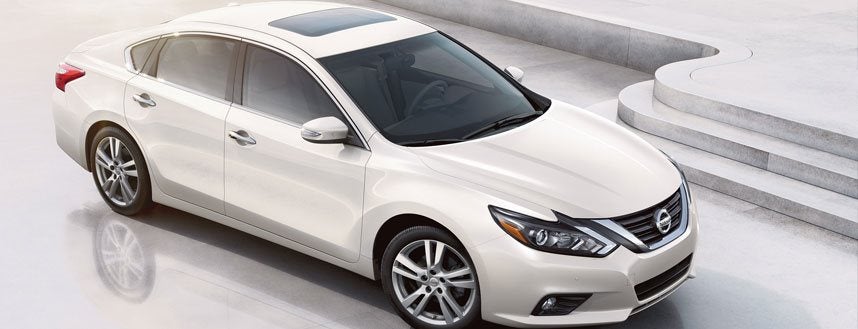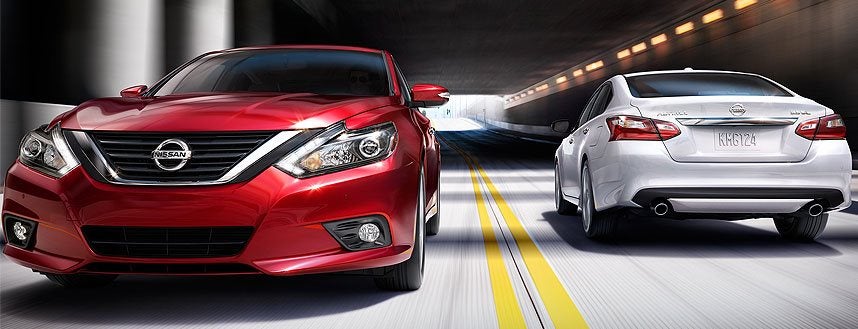
Four of Nissan’s 2016 models have earned top safety awards, and the Nissan Altima is one of those winners. It has a strong safety cage, a rollover sensor, side curtain airbags, and rear head curtain airbags — all designed to keep you and your passengers safe in a crash. In addition, the Altima features innovative technology that works to prevent crashes from happening.
AN IIHS TOP SAFETY PICK PLUS
Every year, the Insurance Institute for Highway Safety (IIHS) tests vehicle models against a rigorous set of criteria to determine which are the safest. Their Top Safety Pick Plus rating goes to the best of the best: those cars that achieve a “good” rating in five categories of crashworthiness, plus have front crash prevention technology that achieves an “advanced” or “superior” rating during testing.The 2016 Altima got top honors, earning a Top Safety Pick Plus rating from the IIHS. Not only did the Altima achieve a “good” rating in each crashworthiness category, but it also achieved a “good” rating in every subcategory, too. Its front crash prevention score was five out of an available six points, earning it a “superior” rating.
THE ALTIMA’S SAFETY RECORD
The criteria for Top Safety Pick and Top Safety Pick Plus has changed over the years; 2016 was the first year cars had to earn a “good” in all five crashworthiness categories. The 2013, 2014, and 2015 Altima models earned Top Safety Picks with a “good” rating in four out of five categories. The only category these three previous Altima models did not earn a “good” rating in was “small front overlap.
THE NISSAN SAFETY SHIELD
In 2013, Nissan introduced their Safety Shield concept.Nissan Safety Shield is Nissan’s way of looking at crash prevention, by dividing it into risk categories and adding automobile technology meant to minimize and eliminate those risks.
The Safety Shield takes into account three phases of safety: monitor, respond, and protect.
The monitor phase encompasses Nissan technology meant to keep tabs both on the driver and the environment around the car. In the respond phase, technology like Blind Spot Warning lets Altima drivers know that their safe driving environment has been compromised, resulting in a better driver response. The last phase, protect, involves keeping the car occupants safe if a crash should occur.
The Altima is just one car in Nissan’s lineup that benefits from Nissan’s improved outlook on safety. Every safety feature available for the Altima is part of the Safety Shield lineup of technologies. Nissan started achieving strong ratings from the IIHS in 2013, the same year they introduced Safety Shield.

THE ALTIMA’S AIRBAGS
Nissan engineers designed the 2016 Altima with six airbags. The two front airbags come with seat-belt and seat occupant sensors. The driver and front passenger also benefit from supplemental side airbags. Finally, curtain airbags, mounted in the roof, protect the heads of both the front and back passengers. Rollover sensors tell the curtain airbags when to deploy. When the IIHS measures side safety, they take into account head and neck injuries for both front and back passengers. Nissan’s “good” rating in every subcategory goes to show how effective these airbags are, even for rear passengers.
A STURDY CAR CONSTRUCTION
The Altima benefits from Nissan’s Zone Body Construction with front and rear crumple zones. The hood has safety stops and buckling features. In 2016, Nissan added reinforcement to the front end, the door sill, the hinge pillar, and the footwell. These strength reinforcements are what pushed the 2016 Altima from an “acceptable” to a “good” in the small front overlap crash category.
When the IIHS does roof strength tests, they expect the roof to withstand pressure at least four times the vehicle’s weight to achieve a “good” rating. The 2016 Altima’s rating is 5.29; it withstood 16,485 pounds of pressure before the test plate crushed it.
FORWARD COLLISION PREVENTION TECHNOLOGY
The technology that won the Altima a “superior” rating in front crash prevention is impressive indeed. In the IIHS low-speed autobrake test, the Altima avoided a collision at 12 miles per hour. In the high-speed autobrake test at 25 miles per hour, the Altima’s forward collision prevention technology reduced crash impact by 10 mph.
In the Altima, optional Predictive Forward Collision Warning monitors two vehicles ahead of you in your lane with radar. If the vehicle ahead of you decreases speed, the Altima warns you visually and audibly. Even if you don’t brake fast enough, the Altima has optional Forward Emergency Braking. This technology monitors your speed and keeps tabs on how close you are to the cars in front of you. If it detects the warning signs of a forward collision, and you don’t brake quickly enough to prevent a collision, the Altima brakes for you.
MONITORING SAFETY TECHNOLOGIES
Additional Altima optional safety features alert you to potential dangers around your entire vehicle, and they fall into Safety Shield’s “monitor” category. Blind Spot Warning lets drivers know with two visual cues that there’s a vehicle in the Altima’s blind spots. A visual indicator appears on either the driver’s door or the front passenger’s door. A warning also appears on dashboard Advanced Drive-Assist Display. Finally, if you turn your turn signal on as though to move in the lane with the blind spot obstruction, a chime sounds.

Available Rear Cross Traffic Alert helps you when you’re backing out of a parking spot, alerting you to any cars about to cross your path. Make backing out of parking spots even easier with a RearView Monitor, which uses a camera to show you what’s directly behind you. All you have to do is put your car in reverse, and the feature turns on. Note that not all of these technology features are available for every Altima model.
SAFER DRIVING IN THE ALTIMA
Nissan has made handling improvements to the 2016 Altima that make the car both drive better and safer. Active Understeer Control knows when you’re making a turn, and it can help you out if you start to lose control. This impressive technology feature is able to brake a single wheel to help the driver handle the sharpest turns. Active Understeer Control comes standard on the base Altima model. It combines with standard front strut suspension and multi-link rear strut suspension to give the Altima good handling that helps the driver maneuver the Altima more safely.
Vehicle Dynamic Control (VDC)and Traction Control System (TCS) both come standard on the Altima’s base model. VDC uses sensors to monitor driving conditions and is able to reduce wheel slip with the help of TCS. Together, they detect which wheel is sliding and apply the brakes to a single wheel to transfer control to a wheel that isn’t slipping, helping the driver regain control of the car. VDC is also able to brake a single wheel to prevent over- and under-steering.
afety is a top concern for drivers everywhere, which is why the Top Safety Pick Plus rating is so important. When the IIHS safety criteria became more rigorous, Nissan rose to the challenge and improved the Altima, earning it the highest rating yet. If you’re interested in a car with the best in safety features, visit Nissan of Cool Springs for an Altima test drive.